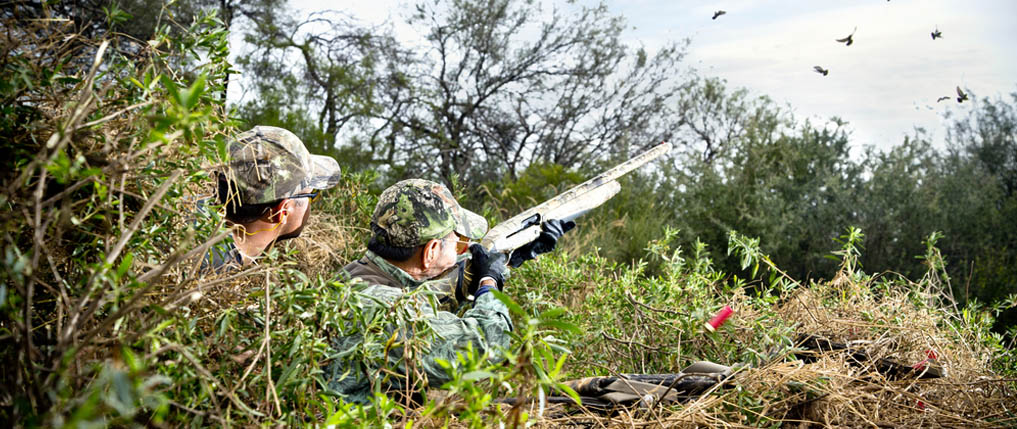How to Dove Hunt
September 7, 2020

Dove openers tend to make the start of hunting season. A fine time to go dove shooting, this easy hunt also hones your marksman skills, preparing you for larger game–like larger turkey!–later in the season.
Plus, getting started with dove hunting is actually quite easy and great for beginner wingshooters. From must-have hunting gear to scouting a field in camo, here is how to dove hunt and bring home good game.
Must-Have Dove Hunting Gear
Before we dive into how to dove hunt, it’s important to talk gear. If you have hunted birds before, you likely already have everything you need. But if you are a novice wingshooter, here is a quick list:
- Hunting license
- Migratory bird permit
- Shotgun and waterproof shotgun case
- Shotgun shells and waterproof ammo case
Use Dove Decoys
Decoys are handy for bird hunting. When hunting mourning doves, keep a dove decoy nearby, attached to a fence or stand. Today, you can find a variety of decoy styles, such as shell and full-body. For a truly convincing decoy, use a battery-operated robo-drive version to mimic lifelike motions.
Once you select a dove decoy, keep a few on the ground and situated on a fence or dead tree limb. Use several decoys along a fence wire, placing them one foot apart from one another. In trees, place decoys as high as you can and away from the tip of the branch. Lastly, because doves take off and land into the wind, be sure to face the decoys into the wind.
Recognize Dove Habits

Mourning doves have several habits that can help you identify the game’s whereabouts. Here are some of the common dove habits to keep in mind when dove hunting:
Doves typically visit a watering hole just after dawn and then feeding areas roughly midday, where they will linger a few hours in nearby perching, watering or graveling sites. Before they head back to roost for the night, they will return to the feeding area in the afternoon, and then the watering hole.
With short, weak legs, doves seek out seeds on bare, flat ground. And where there are seeds, you will find doves. Doves more notably feed on seeds from sunflowers, corn, wheat and other grains, as well as weed seeds like foxtail and croton.
Scout Areas for Doves
Once you recognize a dove’s daily habits and know where to look, it’s time to scout the area to determine the best time to hunt. Pinpointing their water hole and feeding visiting hours can set you up for success, too. Here are basic steps for scouting an area:
Scan the site in the early morning (before 9 a.m.) or afternoon (after 3 p.m.) with binoculars, searching for activity. If you spot a few doves, wait long enough to see if more join. If so, this indicates a hunting site.
For crop fields, determine when doves arrive and when they leave, making a note of the “structure,” or orientation, they fly off to. If you see a dip in timber, it can indicate a travel lane. Field corners may also funnel doves. Doves also prefer a hump in an open field where they can keep an eye out for danger. Doves tend to loaf on power lines and the like, too.
Feeding fields offer a good game, but only with more hunters around to stir doves up. Just make sure not to scare them off to a new feeding spot.
Watering holes, especially muddy ponds and stream banks with open, vegetation-free shorelines, are also ideal. If it’s near a feeding area or roost, even better!
Since doves eat grit to help digest seeds, gravel sites offer another hunting site. Check unpaved roads, sand bars, quarries and other similar spots that might attract doves. These areas work well for a midday hunt as doves loaf between feedings.
When dove hunting, be mindful of each site’s conditions, as well as the weather forecast. Choose a few sites and be sure to visit them often to ensure they are still viable hunting spots. Watch the doves come and go to determine their patterns.
Wear Camouflage Clothing
With shape sight and perched from a high vantage point, doves can spot you pretty easily. To better conceal yourself, wear camouflage clothing to blend into your surroundings, whether it’s tall blonde wheatgrass or dark green trees. Use the natural materials nearby to conceal yourself even further. Wrap your gun and your gun case in camo tape. Lastly, apply camo grease paint across your face, too.
As you learn how to dove hunt, remember to be patient. Wait for the perfect opportunity and you will find good game, ending up with a dove or two.

SIGN UP FOR EXCLUSIVE OFFERS
Sign up for our newsletter and get exclusive access to new product launches, special offers and much more.
RELATED BLOGS














